Mayonnaise, often called “mayo,” is a creamy condiment beloved worldwide. But What Is Mayonnaise Made Of? This article delves into the essential ingredients of mayonnaise, exploring both store-bought and homemade versions, and provides tips for making your own delicious mayo.
Homemade Mayonnaise being drizzled over a salad.
The Basic Components of Mayonnaise
Traditionally, mayonnaise consists of a few simple ingredients:
- Egg: The primary emulsifier, binding the oil and water-based components together. Egg yolks are richer and create a more stable emulsion, but whole eggs can also be used for a lighter flavor.
- Oil: The main ingredient, providing the creamy texture and richness. Neutral-flavored oils like canola, safflower, or sunflower oil are commonly used to avoid overpowering the other flavors.
- Acid: Vinegar (white, apple cider, or wine vinegar) or lemon juice balances the richness of the oil and helps preserve the mayonnaise.
- Salt: Enhances the flavor and acts as a preservative.
What is in Store-Bought Mayonnaise?
While the basic principles remain the same, commercial mayonnaise often includes additional ingredients:
- Sugar: Added for sweetness and to balance the acidity.
- Preservatives: Such as calcium disodium EDTA, to extend shelf life.
- Flavorings: Natural or artificial flavors to enhance the taste.
It’s essential to check the ingredient list on store-bought mayonnaise, especially if you have dietary restrictions or prefer a more natural product.
What Is Mayonnaise Made Of at Home? Key Ingredients Explained
Making mayonnaise at home allows for complete control over the ingredients. Here’s a closer look at each component:
- Egg: As mentioned, the egg is crucial. Use fresh, pasteurized eggs to minimize the risk of Salmonella.
- Oil: Choose a neutral-flavored oil. Extra virgin olive oil can be used, but its strong flavor can be overpowering. Light olive oil, safflower oil, or avocado oil are excellent options.
- Acid: The choice of acid significantly impacts the flavor. Lemon juice provides a bright, citrusy taste, while different vinegars offer varying levels of tanginess.
- Mustard: While optional, adding a small amount of Dijon mustard helps stabilize the emulsion and adds a subtle flavor.
- Salt and Other Seasonings: Adjust the salt to your preference. You can also add pepper, garlic powder, or other spices for a customized flavor profile.
Step-by-Step: Making Homemade Mayonnaise
Here’s a simple recipe for making mayonnaise at home:
Ingredients:
- 1 large egg (or yolk)
- 1 tablespoon Dijon mustard (optional)
- 1 tablespoon lemon juice or vinegar
- 1/4 teaspoon salt
- 1 cup neutral-flavored oil
Instructions:
- Combine the egg (or yolk), mustard (if using), lemon juice/vinegar, and salt in a food processor or blender.
- Process for about 20 seconds until well combined.
- Slowly drizzle in the oil while the processor is running. Start with a few drops at a time until the mixture begins to emulsify.
- Once the emulsion starts, you can gradually increase the speed of the oil stream.
- Continue adding oil until the mayonnaise is thick and creamy.
- Taste and adjust seasonings as needed.
Tips for Success
- Temperature: Ensure all ingredients are at room temperature for better emulsification.
- Slow Addition of Oil: This is the most critical step. Adding the oil too quickly can cause the mayonnaise to break.
- Equipment: A food processor or immersion blender works best. You can also make it by hand with a whisk, but it requires significant effort.
Troubleshooting Common Mayonnaise Problems
- Broken Mayonnaise: If the mayonnaise separates, stop adding oil. In a separate bowl, whisk another egg yolk with a teaspoon of lemon juice or vinegar. Slowly drizzle in the broken mayonnaise while whisking constantly until it emulsifies.
- Too Thick: Add a teaspoon of water or lemon juice to thin it out.
- Too Thin: Continue adding oil very slowly until it reaches the desired consistency.
Creative Ways to Use Mayonnaise
Mayonnaise is a versatile condiment with countless uses:
- Sandwiches and Wraps: A classic addition to sandwiches, burgers, and wraps.
- Salad Dressings: Use as a base for creamy salad dressings like ranch, blue cheese, or Thousand Island.
- Dips: Perfect for dipping vegetables, fries, or chicken fingers.
- Sauces: Use to make tartar sauce, aioli, or remoulade.
- Baking: Adds moisture and richness to cakes and muffins.
Is Mayonnaise Healthy?
Mayonnaise is high in fat and calories, so it should be consumed in moderation. However, it can be part of a balanced diet. Homemade mayonnaise made with healthy oils can offer some nutritional benefits.
Conclusion
Understanding what is mayonnaise made of allows you to make informed choices, whether you’re buying it at the store or making it from scratch. Homemade mayonnaise is a rewarding culinary experience, offering superior flavor and control over ingredients. With a few simple ingredients and a bit of patience, you can enjoy this classic condiment at its finest.
